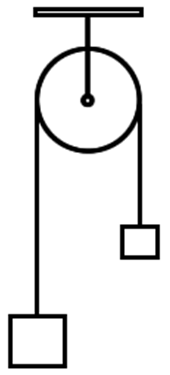Interlude B: Strings and Pulleys
1/13
Earn XP
Description and Tags
Section B.2
Name | Mastery | Learn | Test | Matching | Spaced |
|---|
No study sessions yet.
14 Terms
What are the assumptions for an ideal string?
Massless, stretchless, remains taut
What are the implications of the assumptions for the ideal string?
The tension is the same at both ends of the string
Objects connected by a string must move the same distance during a time interval
Have the same change in velocity during a time interval
Have the same acceleration
How do the magnitudes of the tensions at the two ends of the string compare?
The tensions were equal
How do the accelerations of the two subsystems (left and right blocks) compare?
The accelerations were equal
What is a pulley?
The change of directions of a string and, therefore, the direction of the tension force it applies
What are the assumptions of an ideal pulley?
Massless, frictionless axle or bearings, string does not slip
What is the implications of the assumptions?
The tension is the same at both ends of the string
We will assume that all strings and pulleys are ideal. What conclusions can we make based on these assumptions?
The accelerations of objects connected by a string are equal
The tension is the same at both ends of the string
Ideal strings and pulleys transmit:
The same acceleration and the same tension throughout the connection
Sometimes a string passes over a pulley. All the pulley does is:
Change the direction that the tension force is applied

What is the name of the following device?
Atwood’s machine

How do the accelerations of the two masses in the following figure compare?
a1x = a2x
How do we know which direction to choose for the kinetic friction force?
There are no surroundings that would cause a block to move leftward. The block must move right, and the kinetic friction force would be leftward to impede this motion
Why would there be no kinetic friction acting on a block?
It would not be in contact with a surface that could provide a kinetic friction force